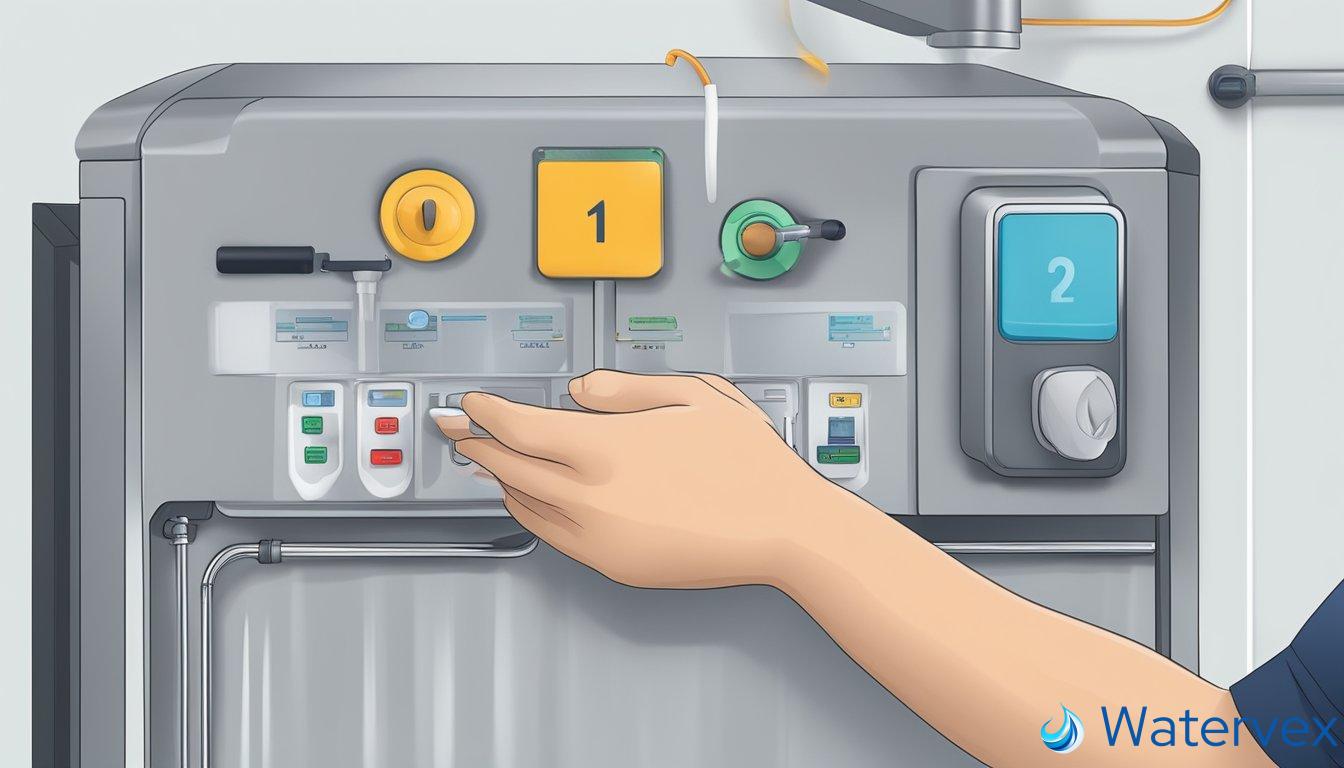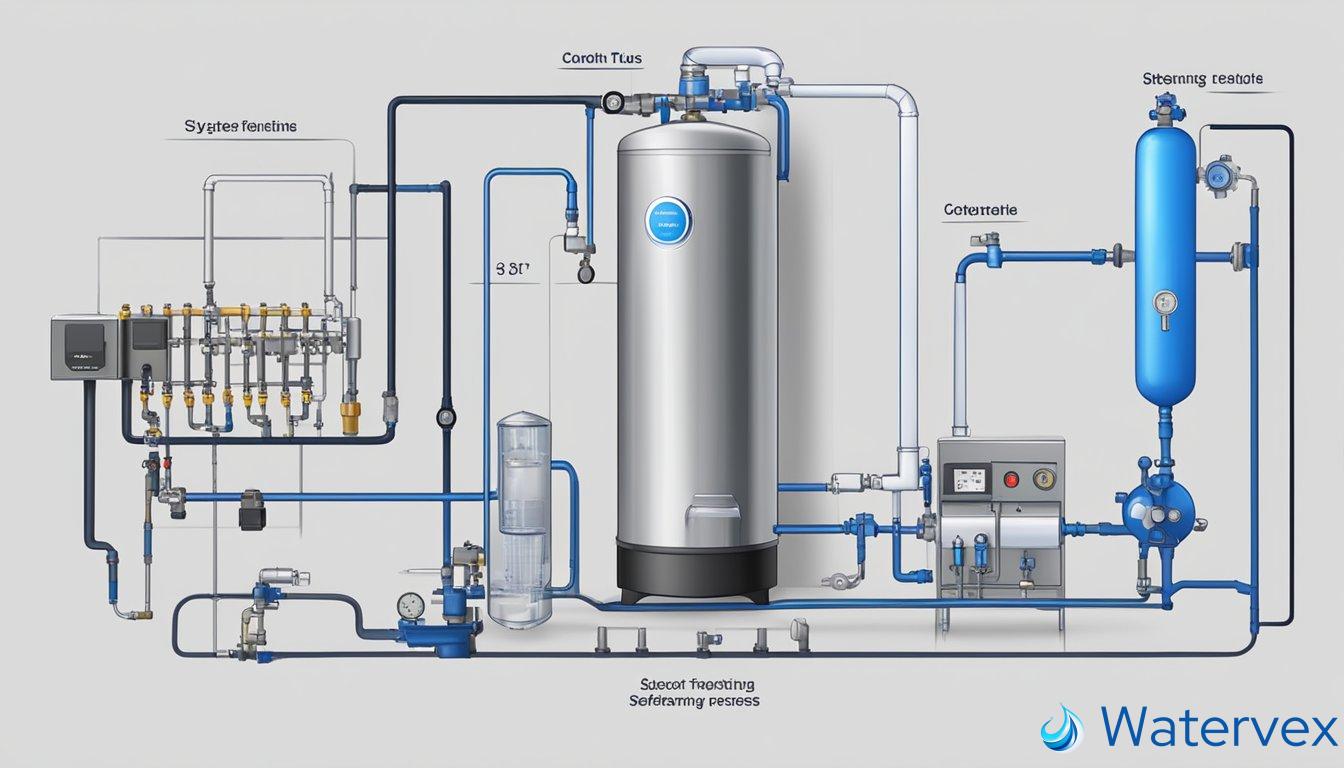Water softeners play an essential role in maintaining the quality of your home’s water by removing minerals that cause hardness. However, there may be times when you need to stop your water softener from regenerating, either because it’s malfunctioning or it’s not necessary at that moment. Understanding how to do this can save you from the inconvenience of untimely regeneration cycles.

When a water softener regenerates too often or at the wrong times, it can be inefficient and costly. The process typically involves recharging the resin beads that filter out calcium and magnesium from your water. If you notice your system is regenerating more frequently than it should, taking the appropriate steps to control the cycle is vital for the longevity of the unit and the quality of your water.
Key Takeaways
- Stopping a water softener’s regeneration can protect its efficiency.
- Controlling regeneration is key for long-lasting equipment and quality water supply.
- Immediate action can resolve unnecessary regeneration cycles.
How to Halt Your Water Softener’s Regeneration Cycle?
When your water softener unexpectedly initiates the regeneration process, your immediate reaction might be uncertainty about how to stop it. Luckily, specific steps can be taken to halt this process without causing harm to your system.
Immediate Steps to Stop Regeneration
Unplugging the Device: The most straightforward action is to unplug the water softener from the electrical outlet. This will not terminate the current cycle but will prevent it from advancing further.
Bypass Mode Activation: Locate the bypass valve often found at the back of your softener. Turning it will redirect water flow and stop the softener’s operations without affecting your home’s water pressure.
Control Interface: Modern water softeners often have a control valve with a manual override button or dial. Utilize this feature to immediately cease the regeneration.
Water Usage Reduction: Minimizing the use of water in your household can prevent the initiation of the regeneration cycle if it’s set to start based on water flow.
Understanding the Regeneration Cycle
To prevent future unexpected regenerations, comprehending the cycle and maintenance needs of your unit is key. The cycle is typically governed by a timer setting on your control valve, which dictates when regeneration occurs.
Adjusting the Timer: By managing the timer settings, you can ensure regeneration occurs at a time that suits your schedule, preventing any need for abrupt stops.
Regular Maintenance: Periodic checks and upkeep of your water softener will minimize the chances of unforeseen regeneration cycles and contribute to the system’s longevity.
By taking these steps and gaining an understanding of your water softener’s operations, you can assert greater control over the regeneration process and ensure your softener functions in harmony with your household needs.
Why Is My Water Softener Regenerating and How Can I Control It?

Your water softener automatically regenerates to maintain water quality, but you have the power to control this cycle.
Regeneration Process and Control
Regeneration is the key process in which your water softener restores its ability to remove hard minerals from your water. It involves reversing the ion exchange process by flushing the resin beads with a high concentration of salt solution from the brine tank. Essentially, regenerating means recharging the resin with sodium ions, which binds to the calcium and magnesium in hard water. This automated maintenance ensures your water softener can continue to produce soft water.
But when does your water softener decide it’s time to regenerate? There are generally two types of regeneration cycles: time-initiated regeneration and demand-initiated regeneration. The former follows a preset schedule regardless of actual water usage, while the latter adapts based on water consumption. Knowing which type your softener uses is the first step in taking control.
Do you need to prevent a scheduled regeneration? Locate the control valve, usually found on the resin tank. This is where you can manipulate the cycle manually. By turning the valve with a screwdriver, you can halt the process temporarily. For water softeners set on a timer, adjusting this timer programming is crucial if you wish to change the regeneration frequency.
Adjusting Regeneration Frequency
Maintenance and adapting the settings to suit your water usage can prevent unnecessary regenerations. By keeping an eye on the salt level and the quality of your water, you can infer the efficiency of ion exchange and, thus, the need for regeneration.
For time-initiated systems, consider adjusting the timer to match your actual water usage. This involves reprogramming the cycle to occur when it’s truly needed, such as during periods of low water demand or during recommended maintenance intervals.
For systems with demand-initiated regeneration, check if the settings accurately reflect your water consumption patterns. Misconfigured or outdated settings can cause the system to regenerate more often than necessary, wasting water and salt. By fine-tuning this feature to align with your water usage, you can efficiently manage the regeneration process without excess or insufficient cycles.
By understanding your water softener’s regeneration mechanism and adjusting the settings accordingly, you effectively take the reins of your home’s water quality maintenance. Keep the ion exchange process in check, and you’ll extend the lifespan of your water softeners while ensuring the best water quality for your family’s needs.
What Immediate Steps Should I Take If My System Won’t Stop Regenerating?

If your water softener is stuck in a continuous regeneration cycle, it’s crucial to act quickly to prevent excessive waste of water and salt. Here’s what you can do right now.
Troubleshooting Continuous Regeneration
First, place your system into bypass mode to stop the flow of water through the softener. This will allow your household water supply to continue unimpeded and give you time to address the issue without more wasteful cycles. Then, if accessible, inspect the control valve; it’s the brain of your softener and any malfunctions here could cause non-stop regeneration. Some models enable you to push through the cycles manually—consult your user manual for specifics.
Regeneration Errors and Solutions
Look for obvious faults such as a stuck valve or incorrect settings that might have triggered an endless regeneration. A control head failure is a common problem; if the control head is broken, customer service or a professional may guide you through a replacement process. For ongoing maintenance, keep a list of FAQs and steps handy in case common problems arise again. If these steps don’t solve the issue, get in touch with a technician who can further assist with repairs or necessary maintenance.

